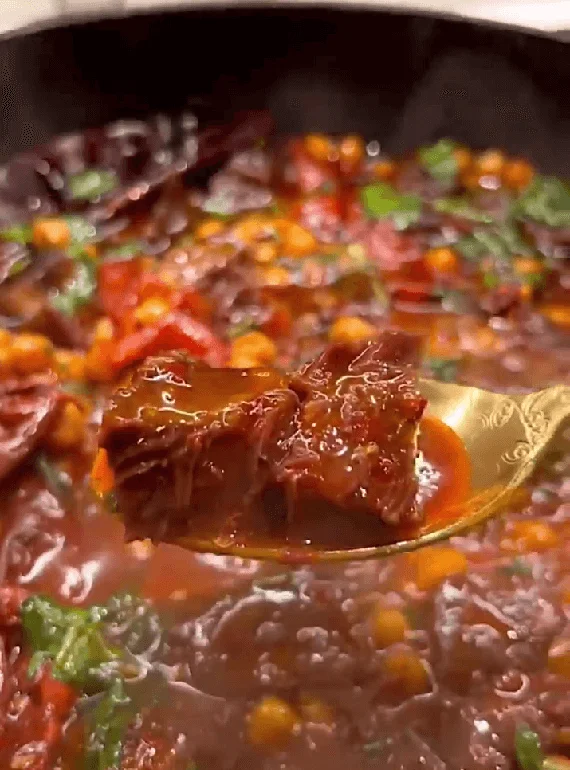Rich and Spicy Moroccan Beef Stew with Melting Chickpeas
We may earn a commission from recommended products, at no extra cost to you. See Disclosure.
INGREDIENTS
- 4½ pounds/2 kilograms beef cheeks
- 1 onion, quartered
- 1 celery bunch
- Water to cover the meat
- 2 tablespoons oil
Sauce:
- 2 cups chickpeas, soaked over night (or canned chickpeas)
- 10 garlic cloves
- 1 cilantro bunch, chopped
- 8 crushed red pepper
- 1 red bell pepper, cut into strips
- 1 tablespoon sweet paprika
- 1 tablespoon crushed red pepper
- 1 teaspoon cumin
- 1 tablespoon tomato paste
- ⅓ ground black pepper
- 2 tablespoons oil
Red oil:
- ¼ cup oil
- 1 tablespoon paprika
- 2 garlic cloves, minced
INSTRUCTIONS
- Heat up the oil in a pot over medium-high heat and sear the beef cheeks on all sides for about 4 minutes. Add the onion and celery, add water to cover the beef, cover with a lid and cook over medium-low heat for about 2 hours.
- Filter the water and save it. Allow the beef to rest for 5 minutes, then cut it into cubes (optional: you can remove the fat at this point).
- Heat up the pot again over medium-high heat and add 2 tablespoon of oil.
- Fry the red pepper strips until tender. Add the garlic cloves, spices, chickpeas and chili peppers and mix. Add the beef and fry for another 3 minutes, while stirring. Pour in the cooking water you set aside earlier to fully cover the beef. Bring to a boil and cook for 10 minutes over high heat. Lower to low heat, cover with a lid and cook for 2 hours.
- Uncover, add the red oil and cilantro and cook for 15 minutes to reduce the liquid. Turn off the heat and wait 10 minutes. Serve with fresh bread.
RECIPE NOTES
- This stew can also be made with minute steak roast, shank and short ribs.
- If you use a different cut than the beef cheeks, don’t forget to add salt. There’s no salt in this recipe since beef cheeks tend to be very salty naturally.

FAQ
The secret to a good beef stew
To make a delicious beef stew, start with fresh and high-quality ingredients. Properly brown the meat to create a flavorful crust and caramelization. Build layers of flavors by sautéing aromatic vegetables before adding the meat. Cook the stew low and slow to allow the flavors to meld and the meat to become tender. Balance the seasoning by tasting and adjusting gradually. Finally, let the stew rest before serving to enhance the flavors and thicken slightly.


Do you have to brown stew meat before slow cooking?
While not strictly necessary, browning stew meat before slow cooking greatly enhances flavor and texture. Browning creates a rich and complex flavor profile through caramelization and the Maillard reaction. It improves the meat’s texture by sealing in juices and keeping it tender. Additionally, browning adds an appetizing golden-brown color for visual appeal when serving.


Is beef stew better on stove or crockpot?
Both stovetop and crockpot cooking methods have advantages and can produce a delicious beef stew. Stovetop cooking offers quick cooking, enhanced flavors, and more control over the process. On the other hand, the crockpot provides convenience, tender meat, and hands-off cooking. The choice depends on your time availability, desired involvement, and flavor preferences.
Can you over simmer a beef stew?
Extended simmering of a beef stew can lead to negative outcomes. Overcooked meat becomes overly soft and loses texture. Flavors may become muted or diluted. Simmering for too long can result in a thicker, more concentrated consistency. To prevent this, follow the recipe’s cooking time or monitor the stew closely for meat doneness and flavor development.

What are the 3 advantages of stewing as a method of cooking?
Stewing tenderizes tough cuts of meat by breaking down collagen, resulting in juicy and easily shreddable meat. It enhances flavors as ingredients simmer and infuse into a rich broth. Stewing retains nutrients due to its gentle and prolonged cooking, preserving vitamins and minerals while creating a nourishing dish.

